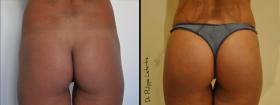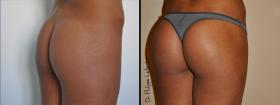Buttocks cosmetic surgery augmentation with prosthesis
What are the motivations for buttocks augmentation ?
Whether you are a woman or a man, many of you may find their buttocks underdeveloped, too flat or drooping and wish to have fuller,rounder or curved buttocks.
Three possible surgeries
Three techniques are used today to increase buttocks :
- Buttock implants or prostheses
- Lipofilling or fat injection
- Macrolane or hyaluronic acid injection
Buttocks augmentation with prosthesis
Buttock implants are soft as breast implants, but much more resistant.
They are composed of solid or cohesive silicone gel which prevents leaking even if there is a crack of the wall.
The appearance of the implants is very natural.
What are the objectives of cosmetic surgery ?
Buttock augmentation with prosthesis consists in correcting the shape and size of buttocks by inserting a buttock prosthesis.
This will enable large and round buttocks.
Your new buttocks will then have new curves, as desired.
Can we choose the prosthesis size ?
Yes, you determine together with your surgeon, the size and shape of the buttocks prosthesis that suits you best.
He will advise of the implant volume adapted to your body, so that the result is as natural as possible.
Currently several buttock implants are available, which differ in size, surface and shape.
You can compare them during your consultations.
What happens during the surgery ?
The implant is positioned between the muscle tissues of the gluteus maximus, in the upper half of the buttocks. It will not move because a space is specially designed for him.
+ What is the type of anesthesia ?
The intervention is performed under general or epidural anesthesia and mild sedation. This decision will be the subject of a discussion between you and your surgeon during a consultation.
+ Where is located the incision ?
The implant is inserted through an incision in the inter gluteal fold.
+ And the scar ?
The scar, located in the inter gluteal fold, hidden by underwear,remains very discreet, almost invisible.
What are the postoperative courses ?
The average hospital stay is 3 days. Two Redon drains are placed to evacuate the blood, they will be removed the following day.
Powerful painkillers are prescribed to relieve pain.
You will feel your buttocks tense until your skin adapts to the new curves.
You must wait 24 hours before sitting down, and 48 hours before walking.
It will take three months minimum to go back to practicing a sport where your buttocks muscles have to work, and three weeks for a normal daily activity.
The first weeks, you must not sleep on your back and sit up straight when you are sitting.
It is advisable to wait a year before pregnancy.
What is the expected result ?
You must wait about three months before appreciating the final result, while your body gets used to your new curved buttocks. Your silhouette is transformed with a new gluteal curvature, in a higher position.
It takes about 15 years before changing implant.
What are the possible complications ?
Following any operation whatsoever , certain complications can occur, the first ones related to the medical activity and the others to anesthesia.
Although possible complications only represent a small percentage, it is necessary to know them.
+ What are the specific risks of anesthesia ?
During your obligatory talk with the anesthetist, he will inform you in detail of the risks of anesthesia.
It is useful to know besides that during the last twenty years, the risks have not been eradicated but remain almost insignificant.
+ What are the specific risks of the surgery ?
During the consultations with your surgeon all the possible complications will be detailed to you.
To inform you in advance, here are the possible risks:
- Hematoma : if heavy bleeding occurs, it will require an evacuation.
- Unfavourable evolution of the scars : it will require a special treatment, sometimes long.
- Infection : It is fortunately unusual but may require further surgery and removal of the prosthesis. You will have to wait a few months before getting new implants.
- Capsule formation : To defend against a foreign body, our body naturally forms a "periprosthetic capsule." This membrane, normally invisible, may be detectable by thickening and becoming fibrous. Surgery can correct this complication.
- Implant rejection : This is fortunately unusual, and choosing a qualified surgeon reduces this possibility.
- Thromboembolic accidents (phlebitis, pulmonary embolism), the most serious complication, are exceptional and precautions are taken to reduce risk.
These informations given by Dr. Philippe Letertre should only be a help or a supplement to your surgeon’s consultations
Our space "Questions / Answers" is also available for you.
Feel free to contact Dr. Letertre
so that he could meet your expectations.



